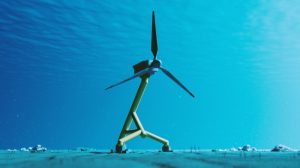
This novel morphing blade concept is based on innovative structural design features that enable the trailing edge to effectively adapt to the flow conditions and enhance its fluid mechanics characteristics in response to uneven and variable loading conditions.
This passive approach improves resilience and reliability and consequently can substantially decrease the levelised cost of energy (LCOE).
Application
Development Status
IP Status
Commercial Offering
Opportunity
Tidal energy can play a vital role in future energy decarbonization efforts as a reliable and renewable energy source. However, a key technical challenge of harvesting energy from tidal currents is the large load fluctuations experienced by the blades. These can result in fatigue failures of the blades and in power fluctuations at the generator, and thus in a lower mean power when load peaks correspond to rated power.
New technologies are needed to overcome this challenge. A further imperative is that such solutions add minimal complexity, to ensure high resilience and reliability, and thus effectively decrease the LCOE and boost the competitiveness of this sector in the energy market.
Technology Overview
In response to this, Professor Viola, Dr McCarthy and colleagues at the University of Edinburgh have developed a new flexible blade design that deforms to optimise performance in the face of varying conditions the turbine system is exposed to. The pressure and suction surfaces of the blade are designed to flex independently of each other, allowing the blade sections to easily camber under an external load. By tailoring the blade properties, its camber reduces under heavy loads; this limits the maximum loads generated by the turbine providing a limit to the maximum torque transferred to the turbine generator. Analogously, under light load, the blade increases its camber to increase the power generated.
In contrast to current state-of-the-art approaches, which employ complex sensing and actuating mechanisms to vary the geometries of blade elements, the Edinburgh concept is entirely passive in nature and mechanical mechanism-free. The morphing characteristics are an inherent property of the blade structure itself, making it durable and offering the potential for higher resilience, better reliability, longer lifetimes, lower susceptibility to structural fatigue and ultimately reducing the levelised cost of tidal energy.
Benefits
Publications
https://VOILAb.eng.ed.ac.uk/publications#Energy
Quote: TEC104557

Lead Technology Transfer Manager